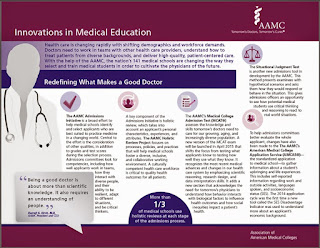Early Data Shows Students Grasping Content Faster, Scoring Higher In New Curriculum
 With the first semester of the new Shared Discovery Curriculum in the books, data is showing that students are getting a good grasp on the content they're learning at a faster pace, consuming the material 50 percent quicker.
With the first semester of the new Shared Discovery Curriculum in the books, data is showing that students are getting a good grasp on the content they're learning at a faster pace, consuming the material 50 percent quicker.“Students even at seven weeks were already clinically performing essentially at the level of students
who were at the end of their first year in the previous curriculum,” said Dr. Aron Sousa, senior associate dean for academic affairs for the medical college. “It’s the experiential learning aspect of the program that’s making this happen.”
Among the many differences between what has been the traditional model of medical education and the College of Human Medicine's Shared Discovery Curriculum include early and ongoing clinical experience for students that integrates the basic and clinical sciences. Whereas schools typically split the learning of the sciences and the clinical experiences, students in Shared Discovery are learning with a hands-on approach.
The competency-based medical curriculum focuses more on learning through clinical experiences beginning within weeks of the first day. This provides an environment for students much closer to residency rather than the settings of a traditional medical school curriculum.
The implementation of learning societies, small groups of students, clinical faculty, basic and social scientists, have allowed students the ability truly absorb information more efficiently.
See "Evolution and Revolution: 5 Takeaways from the New Shared Discovery Curriculum"
It's working.
Sousa says that students are also scoring higher on progress tests that are similar to board exams. While the average score on these tests is 45 for students with a full year of medical school under their belt, the average score for students in the Shared Discovery curriculum is 41 after just a single semester.
A progress suite of assessments gives pace to what the students learn. From the first weeks of medical school and through regular intervals, the assessments enable students and their faculty to verify the achievement of competence and readiness to move through the curriculum.
While the data is still early, it is promising. If the efficiency of the new curriculum holds up, the implications for students could mean entering residency sooner and thus, paying less tuition.
Read the official announcement for more information.




Comments
Post a Comment